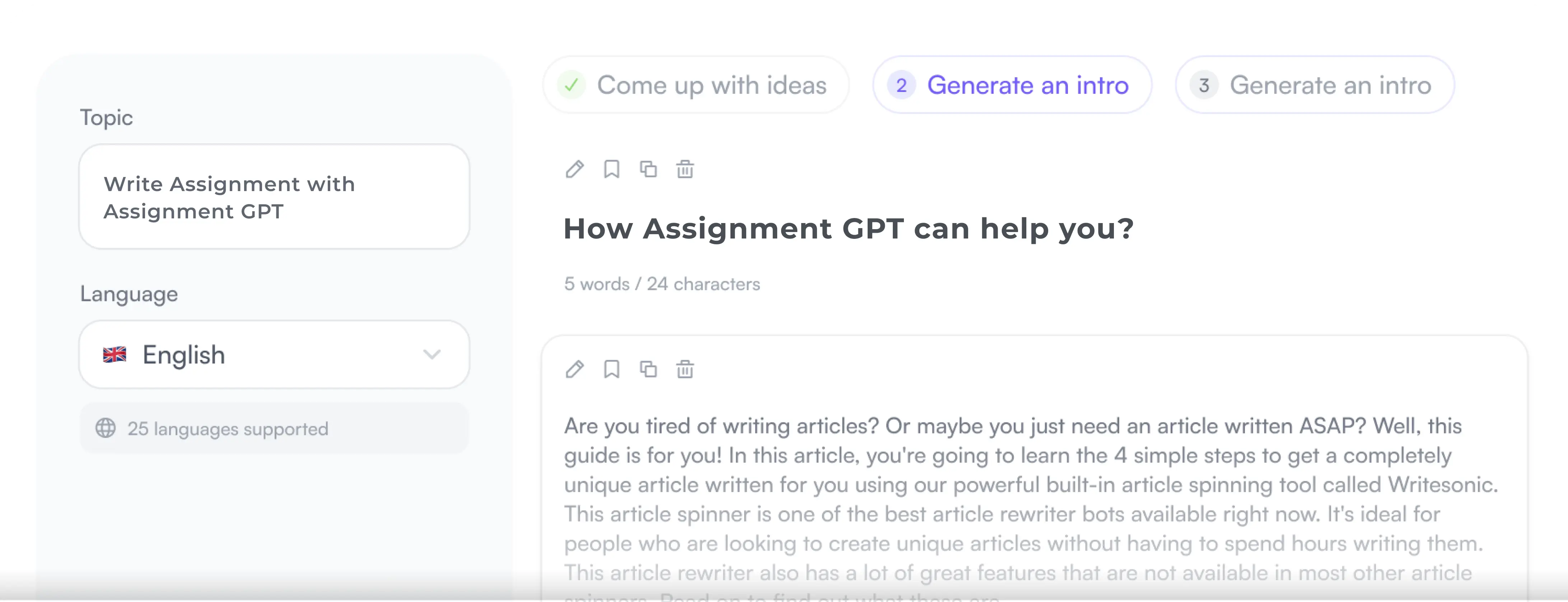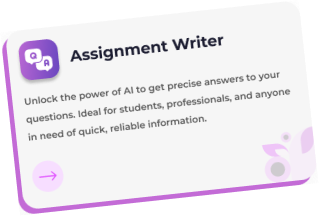AssignmentGPT Blogs
It sounds quite funny to hear that people are generating content from AI for their daily tasks, or content, and now the same people want to rewrite their AI content so that it sounds human. There are many reasons behind making your content look human-written. Some want to bypass AI detection of their college assignments, and some want to avoid a Google penalty.
So, whether you are a content writer, editor, business owner, or marketer, today’s article will prove to be quite helpful because we will know how you can finally rewrite AI content so that it has a human tone and you don’t face the issue of AI detection.
Quick Summary
AI-generated texts are efficient, and they look quite professional, but they lack the human touch. Most people choose to rewrite AI content to bypass AI detection.
Actually, the problem is not in rewriting but in the intention of the person, whether they are rewriting their content for further improvement, quality enhancement, or just to avoid AI and plagiarism detection.
To date, I have written 5000+ professional articles, and today, in this article, I will guide you on rewriting from my personal experience.
Our Focus in this Article:
- What is AI-generated content, and what is the problem with using it?
- What exactly is rewriting?
- What is the process of rewriting?
- Lastly, I will tell you, based on my experience, whether you should do rewriting or not and that too with practical examples.
What Is AI-Generated Text?
If we understand AI-generated text in simple language, then it is such content which is generated by using artificial intelligence algorithms like GPT (Generative Pre-trained Transformer). And all such LLM models which can generate text content with the help of generative AI generate it by using datasets because these tools cannot think or feel on their own, and they make predictions of the next word on the basis of prediction patterns in massive datasets.
For example: You consider it as a kind of machine to which you have given the knowledge of all your books and articles, after this, when you ask the same machine to write content it will try to generate new content using the same knowledge, but in reality that content is not new but is a mixture of previous data.
It may look as futuristic as it may seem because the content is generated quite fast, smooth and professional, but all the things that are missing in that content are there in the content of a human writer.
1. Emotions: Ai can mimic generated content such as emotional language (“I’m thrilled!”) but cannot express feelings, as there is no line structure or emotional depth in the content.
2. Contextual awareness: Ai struggles to understand real-world nuances or specific situations because he does not have as much local information on topics such as culture, religion, festivals.
3. Personal experience: Ai does not have any personal experience or life to share, which is why he uses available human content. This is why publishing companies mostly use human writers.
4. Brand voice nuance: Ai can mimic the brand but can also miss that unique tone sometimes, which can impact the consistency of the brand tone.
That is why I do not prioritize generated text in my content, because if the content is read by humans, then it becomes very important that the content is also written by humans.
Why Is It Important to Rewrite AI-Generated Text?
There are many reasons to rewrite AI-generated content, and as I have noticed, most people’s main concern is to bypass AI detection, but let’s still know why it is so important to rewrite AI-generated content.

To Improve the Clarity & Accuracy of the Text
If you use AI-generated content, you may face many issues, as AI can also make mistakes in the content.
For example, I asked ChatGPT to write a short bio for my musician client. He automatically wrote such a Bio in which he himself claimed that the age of the artist is 40 years, but in reality his age was 26 years, hence one should never rely on the generated text.
1. Rewriting helps catch Factual inaccuracies
If your content has inaccuracies due to AI content, you can find it through manual check, and when you rewrite it, you have time to fix many issues.
2. Overgeneralizations
A model like ChatGPT tries to keep overgeneralizations in its content. It never gives output according to the subject of the content, like even if the content is academic or professional, it will only give general results in the output.
3. Confusing or outdated references
Generative platforms do not know the value of any content or reference. It has validity; hence, if the content is related to a trending topic, then it can make mistakes.
4. To Avoid Plagiarism
By the way, I have noticed that AI does not copy and paste anyone's content; it tries to keep every word unique, but still, the content generated by it contains a mixture of online data, due to this, many times plagiarism issues can arise in the content.
5. Overlapping phrasing with existing content
Generated content often manipulates phrases, due to which the tone of the content sounds quite robotic.
6. Unintentional duplication
Generative models have limited content data, which is why when you create new content, it unintentionally uses the available content for the new content and such content can never be unique.
7. Ethical and legal concerns
ANI had filed a copyright infringement case against ChatGPT, according to them, ChatGPT was using their content without permission for new content generation or learning. For this reason, Google released the E-E-A-T policy so that the originality of the content can be maintained, and it can be disclosed who has written a particular content.
8. To Make It More Engaging and Relatable
Human touch and humour is always missing in this generated content as it does not know what kind of audience a particular site or business has and what type of audience it is, hence it is very important to rewrite such content.
9. To Make It More Creative
As we know, we can never add personal experience, humour, sarcasm, or cultural context to our content. So, if you are a creator, you must know what kind of content your audience will like, and it is your responsibility to provide them with creative content, so you can also use rewriting.
Key Characteristics of Humanized Writing
Let us know what the characteristics are that differentiate human-written content and AI-generated content. I will try to explain this in my personal writing style.

1. Conversational Tone
Whenever I write content, I try to make the language of the content clear and casual, as if I am talking to one of my friends. That is why professional writers always write content in a conversational tone, in which they ask questions to the reader and convey facts.
2. Emotional Depth
There is much content in which I use my own experience. By doing this, human emotions are added to the content, and this quality is never found in generative AI. Because only human writers can add joy, frustration, and experience to the content, it is not possible.
For example, sometimes you hear jokes generated by AI, and then if written by humans, you will feel that AI can never add emotions to the content.
3. Storytelling Elements
I use stories to make any article successful and interesting; due to this, my audience feels good while reading the article, and they do not feel bored.
For this, I use definitions, examples and my experiences in my content, which builds a rich story in my content.
4. Unique Opinions and Perspectives
When I write content, I will share my experiences, preferences, and viewpoints. Can you tell me if AI can ever create such content which includes experiences or viewpoints??
Some Tips for Rewriting AI-Generated Text
Let us know about the important steps that you have to keep in mind while rewriting any AI-generated text.

Step 1: Manual Reading
First of all, you should read the content in detail. For this, you should use a notepad and note what is missing in the content. First of all, read it 1-2 times, do not do such a thing that you start editing by reading the first line. In this, you should pay attention to such phrases which contain all the following.
Awkward sentences: While reading manually, pay attention to changes where your sentence feels clunky or unnatural or disrupts the flow and feel, and try to simplify the structure and word choice so that it feels more conversational.
Stiff tone: Pay attention to where your content is sounding overly formal or robotic, and why it is not building a personal connection, so rewrite it in your active voice.
Inaccurate statements: While checking, pay attention to false or questionable facts, and verify all details and remove or correct incorrect information, which is not similar to your content.
Pro tip: For proofreading, use your own skill and check manually. Do not use an AI tool or a summarizer tool.
Step 2: Fact-Check
This can often hallucinate readers due to inaccurate or misinformation, so it is very important to double-check your content for better accuracy. You can focus on these parts of your content:
Dates: Always check for incorrect or made-up dates; cross-reference with reliable sources to ensure accuracy.
Names: Confirm names of people, places, or things are correct; AI can mix up or invent names.
Stats: Try to validate any numbers or statistics; ensure they come from credible sources, or remove if unverified.
Claims: You should scrutinize bold or vague claims; back them up with evidence or rephrase to avoid misleading readers.
Because I have noticed many times that ChatGPT-generated content is mostly inaccurate and misleading, and if there is no content available on the internet on a topic, it generates more hallucinating content. And this does not make the content good for readers.
Step 3: Remove Any Repetitive or Formulaic Language
AI follows a lot of repetitive words and structure, which is why AI content looks very professional, so whenever you rewrite, pay special attention to the following parameters and fix them.
Repeating keywords: Find overused words or phrases; replace with synonyms or rephrase for variety.
Identical sentence length: Notice uniform sentence structures; mix short, long, and varied sentences for rhythm.
Overused templates: Eliminate clichéd phrases like “In today’s fast-paced world…”; rewrite with fresh, original expressions.
Pro Tip: Use variation in the sentences of your content; for this, you mix questions, exclamations.
Step 4: Add Personality and Creativity
Why not generate content if it is important? If the content is important, it is important to add your personal touch and creativity to it. This will add value to your readers and will also improve your reader loyalty. For this, you should add these to your content:
Add humour: You can use appropriate humour to engage readers and make the text feel human.
Use metaphors: Incorporate vivid metaphors to make ideas more relatable and memorable.
Throw in real-life analogies: Use everyday comparisons to clarify complex ideas and connect with readers.
Include your voice: Infuse your unique tone, style, or perspective to make the content authentic and build reader loyalty.
Example before rewrite: "The software is efficient and reliable"
After rewrite: "Many people experienced that this software is efficient and reliable"
Step 5: Localize or Customize When Needed
Whenever you write content, keep in mind that the audience category for which you are writing content, it must relate to it, because if your content is not relatable to your audience, then it affects the content engagement a lot, so while rewriting, definitely check for which age group the content is suitable and for whom it is not, then you make changes accordingly.
Region: Make sure that the content you publish is relevant to your audience's location, for this you can use local references and terminology.
Age group: Adjust the tone of your content and keep the examples suitable for a particular age group so that your content is engaging to your target age group audience. And try to create intentful content.
Industry slang: Try to avoid any industry terms or words that do not match your audience.
Cultural context: Always make sure that your content respects cultural nuances and avoids references that may seem offensive.
Step 6: Use Active Voice and Human-Centric Language
I always write content in a passive voice, so try to use an active voice while rewriting content and keep the language tone human-centric so that your content doesn't sound robotic.
Step 7: Proofread
When you complete your writing, keep in mind that your content should be at least perfect, for this you use proofreading in which you have to try to fix basic errors, in which you have to check grammar, content structure, and plagiarism. For this, you can use these tools:
Grammarly: This is the leading AI assistant in the writing industry, used mostly by writers and publishers like me. The Grammarly platform is best for grammar, spelling, and punctuation checks. You also get features like tone adjustment, suggestions, and plagiarism detection.
AssignmentGpt AI Writing Assistant: This is a very popular AI tool designed for academic and professional writing. The platform provides grammar corrections, sentence rewrites, and context-aware enhancements to keep your brand quality consistent and unique.
Quillbot: This is an AI powered writing tool specialized in paraphrasing, summarization, and grammar checking and you get multiple models so whether you want to do formal writing or creative writing, you can easily do it.
What Are the Limitations of Rewriting AI-Generated Text?
No matter how perfectly you rewrite, the content can never be completely perfect because if it is done in one way, it is a mixture of available content. You may also have to face many problems while rewriting content like
- It can be time-consuming, especially for long-form content.
- AI “vibes” can be hard to remove completely, especially if rushed.
- There’s a risk of overediting, where you change too much and lose the core idea.
My Recommendation: The rewriting process of any content also varies a lot from topic to topic, and it is a very time-consuming process because you have to do manual checks, outlining and writing. It is better to write original content only.
What Is the Future of Rewriting AI-Generated Text?
These tools will get smarter with time, and as new models like GPT-5 or Cloud 3.5 become more advanced, their writing capabilities will keep on increasing.
But still, human content will always be the first priority for the Google search engine, and it will not be difficult at all for tech giants like Google to figure out whether the content is human-written or AI-generated.
Why Does Google Prefer Human Written Content?
- Machines don’t understand context or emotions, so for such topics in which human emotions play a critical role, Google will always give priority to human content.
- Search query audience needs authentic content, not robotic
- Brands are built on trust, not on templates like content or AI-generated content.
In the future, the rewriting market will increase, but only for casual works; businesses or bloggers will give preference to human content for web content
Conclusion
Rewriting AI-generated text is not an option, but has become essential for many people who want to bypass AI detection. There are many such AI bypass tools and Rewriter tools available in the market. Mostly, the main reason for people to rewrite is AI detection issues, and others want to enhance quality and improve creativity.
My Recommendation: Rewriting any AI-generated content is not at all easy; it is a very lengthy task in which many processes are involved, and even if you rewrite the content, it will never feel real because its writing data will be common, so it is better to write it yourself as per the manual outlining.
FAQ
1. Why does AI content sound robotic?
2. Can't I just use AI detectors to fix the issue?
3. How do I know I've humanised text enough?
4. What tools help rewrite AI text better?
5. Is rewriting AI text considered unethical or illegal?
6. How do I maintain originality and avoid plagiarism with AI-rewritten content?
7. What steps should I take to ensure factual accuracy when rewriting?
Content writer at @AssignmentGPT
Ashu Singh, content writer at AssignmentGPT, crafting clear, engaging content that simplifies complex tech topics, with a focus on AI tools and digital platforms for empowered user experiences.
Master AI with
AssignmentGPT!
Get exclusive access to insider AI stories, tips and tricks. Sign up to the newsletter and be in the know!

Transform Your Studies with the Power of AssignmentGPT
Empower your academic pursuits with tools to enhance your learning speed and optimize your productivity, enabling you to excel in your studies with greater ease.
Start Your Free Trial ➤Start your success story with Assignment GPT! 🌟 Let's soar! 🚀
Step into the future of writing with our AI-powered platform. Start your free trial today and revolutionize your productivity, saving over 20 hours weekly.
Try For FREE ➤








